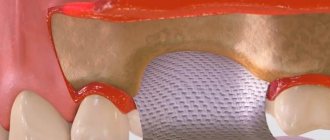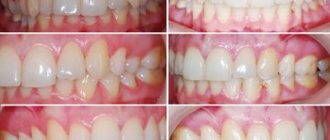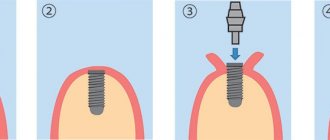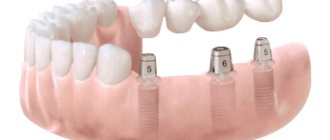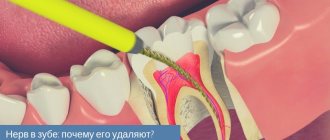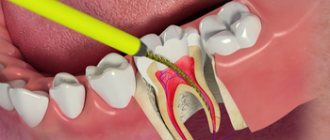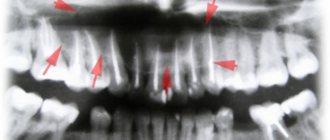According to antiplagiat.ru, the uniqueness of the text as of October 16, 2018 is 99.2%.
Key words, tags: Removal, cystectomy, periodontitis, caries, pulpitis, bone tissue.
In modern dentistry, the feasibility of tooth-preserving operations is steadily increasing. After all, there is no doubt that eliminating the pathological focus that destroys the tooth, instead of removing the entire tooth, is a more correct, gentle path to dental health and a beautiful smile. Therefore, in cases where there is a real chance to save a tooth, we do everything possible to make sure this happens.
Historical reference
The first doctors of human civilization “treated” diseased teeth in the only way - without finding out the reasons, they removed them. But over time, doctors in different parts of the world made attempts to treat teeth, including surgically, as opposed to removing them. This is confirmed, for example, by a fragment of a jaw found by archaeologists, dated approximately 2680-2563. BC, with traces of a successful intravital surgical operation to remove pus1. In the Middle East, the famous surgeon Abu al-Qasim Khalif ibn al-Abbas al Zarawi (936-1013), who lived in the Cordoba Caliphate, advised his followers not to rush into removing teeth, calling them “noble organs.” The most famous surgeon of the 16th century. During the Renaissance, the Frenchman Ambroise Pare (1517–1590), developed surgical methods for excision of epulis and replantation (transplantation) of teeth. On the territory of our country, dentistry, including surgical dentistry, was forced to develop – “thanks” to wars. Surgical dentistry was established on a scientific basis only in 1758, when the very first medical faculty in the history of our country was opened at Moscow University, where they taught, among other things, the skills of surgical dentistry. In pre-revolutionary Russia, the dental system was considered as an autonomous organ, for the treatment of which “handicraft” medical craft was sufficient. Progressive figures in medicine, such as Professor N.V., opposed this point of view. Sklifosovsky, who considered dentistry an undeservedly forgotten branch of surgery. In 1896, the operation of resection of the root apex for chronic apical cementitis entered dental practice. Another significant event in the field of oral surgery was the operation of cystotomy and cystectomy, developed in 1892 by K. Parch.
Surgical dentistry became an independent field of medical science after the First World War - faculties and departments of dentistry and odontology began to open throughout the country, in all 15 republics2.
Thanks to the intensive development of surgical dentistry in the 20th and early 21st centuries, today there are a sufficient number of methods of surgical treatment of teeth for the purpose of preserving them. As a result of the generalization of such surgical interventions, the concept of “tooth-preserving surgery” appeared.
Patient rehabilitation
During the preoperative and postoperative period, the client is advised to avoid physical activity, food intake is allowed three to four hours after the completion of surgery, food should be liquid. Next, you should limit exposure to thermal and taste irritants on the oral cavity, and do not use aggressive rinses and toothpastes. The doctor prescribes the patient to take vitamins, as well as antiseptic, anti-inflammatory and immunostimulating medications.
For three months, a ban is imposed on the consumption of solid foods that require increased jaw work - nuts, fruits, and so on. A prerequisite for a speedy recovery is careful oral hygiene and the prevention of inflammation, with which the specialists of the ILATAN dental network help their patients. The prices for services are affordable; you can find them on the website or by calling the numbers provided.
Tooth-preserving operations and quality criteria for their implementation
Tooth-preserving operations are a group of operations closely related to endodontics, periodontology and surgical dentistry, as they are used when conservative endodontic treatment does not bring the expected effect and surgical intervention becomes advisable. Dental-preserving operations, despite their apparent simplicity, are complex, as they are associated with the risk of accidental damage to the alveolar nerves, nasal sinuses, and incisive canals located close to the operated area. That is why surgical intervention must be extremely correct and thought out to the smallest detail. This requires the surgeon to have fundamental anatomical knowledge supported by extensive clinical experience. The doctor must have an excellent understanding of the etiology, pathogenesis and clinical pictures of inflammatory processes and diseases of the oral cavity caused by them: periodontitis, periostitis, osteomyelitis, pericoronitis, abscesses localized in the oral cavity requiring surgical intervention; know and have excellent command of dental preservation techniques; It is excellent to know and accurately determine the indications for tooth-preserving operations and take into account contraindications to them.
Cyst treatment
Hilar cysts are treated in two ways - therapeutically and surgically. Therapeutic treatment consists of mechanical cleaning of the canals, after which a special disinfectant is sent into them. In order to eliminate the infection, the medication is injected into the cyst itself, and the result will need to wait several months. It is convenient to carry out drug treatment when the canals are not yet filled, when access to the cyst is open and it is possible to reach it.
In the absence of access to cysts, when the root canals are already filled, only the root resection method has proven its maximum productivity and versatility. You can make an appointment directly on the website
Types of tooth-preserving operations
Tooth-preserving operations combine a whole range of dental surgical procedures, among which several main ones can be identified:
- resection of the apex of the tooth roots and retrograde filling of the tooth root, which in some cases is part of this operation;
- hemisection of the tooth;
- tooth root amputation;
- tooth root separation, as well as reconstructive periodontal surgery.
Resection of the root apex is an operation that is performed in cases where a chronic inflammatory process or tumor-like formation is detected in the area of the tooth root - a root (radicular) cyst or granuloma, which is not amenable to conservative therapeutic treatment. Removing the root tip allows you to eliminate the inflammatory focus or tumor-like formation, preserving the tooth. To prevent the spread of the pathological process into the apical tissues, in some cases, retrograde filling of the tooth root is then performed. Such an operation can be carried out in the same way as an independent surgical intervention, in cases where it is impossible to carry out high-quality filling of root canals in the traditional way due to severely curved canals, the presence of pins and inlays in the canals, or instrument fragments.
The operation of hemisection of a tooth is the removal of a damaged, untreatable half of the crown part and the adjacent root from a multi-rooted tooth, usually a lower molar, while preserving the second half of the root and crown.
In cases where conservative treatment of one or two roots of a three-rooted tooth, usually on upper molars, does not lead to the expected result, then root amputation is performed. In order not to remove the entire tooth, they amputate the damaged root, which is the source of the inflammatory process, “transforming” a three-rooted tooth into a two-rooted or single-rooted one.
Coronal-radicular separation (separation) of the tooth crown is a surgical method used by dental surgeons in cases where a multi-rooted tooth, while the roots are intact, is perforated or destroyed in the area of bifurcation (root divergence). Separation of the tooth crown into two parts leads to separation of the roots and the creation of two single-rooted teeth.
In order to preserve teeth and provide bone and soft tissue support, reconstructive periodontal surgeries are performed, among which the main ones can be identified:
- gingivoplasty is an operation to remove excess gum tissue to improve the structural condition of the gums and level the height of the gingival margin;
- plastic surgery of bone pockets with a mucosal flap - an operation to eliminate bone pockets, which are the source of inflammation;
- Osteoplasty with a solid allogeneic graft is an operation to eliminate bone tissue defects by replanting bone-forming materials;
- Directed regeneration of periodontal tissue is an operation to restore destroyed bone structures with special membranes.
All tooth-preserving operations are performed under local anesthesia, and in some cases under general anesthesia. In the postoperative period, the doctor prescribes special care for the oral cavity, including the use of agents that promote healing and elimination of existing oral diseases, in some cases antibiotics, physiotherapy and x-ray monitoring. Strict adherence to all doctor’s recommendations ensures that the recovery process will proceed quickly and without complications.
Preparatory stage
Before prescribing an operation, the dental surgeon conducts a thorough diagnosis using visual and hardware methods. X-ray and (or) computed tomography make it possible to assess the condition of tissues, identify foci of inflammation, and develop a surgical plan. If indicated, a complete sanitation of the oral cavity is carried out: treatment of teeth and gums, a comprehensive professional cleansing procedure. If the elements of the dentition are unsteady, splinting is performed (fixing a splint on loose teeth to stabilize their position).
Indications for tooth-preserving operations
There are many reasons why a patient may need tooth-saving surgery. It is appropriate when pathological processes caused by complicated caries, pulpitis or periodontitis rapidly progress and threaten even more serious complications, for example, atrophy (resorption) of bone tissue and its subsequent decrease. Another indication for tooth-preserving surgery is the low quality of dental canal filling and mechanical perforation of tooth roots as a result of conservative dental procedures. Many patients wearing metal-ceramic orthopedic structures have destructive changes in the periapical tissues due to the fact that the dental canals under the crowns were poorly treated and filled (that is, not to the root apex), which can also be eliminated with tooth-saving surgery.
In particular, tooth-preserving surgery will be the optimal solution in cases where a crown or bridge is installed on a tooth, and removing the entire tooth will weaken the structure, while removing part of the root will justify the efforts invested in restoring the dentition. In addition, the following factors are indications for tooth-preserving operations:
- presence of a deep pocket,
- perforation of the bottom of the pulp chamber,
- obstruction of the root canal due to the presence of a cyst or granuloma,
- the presence of pathological foci in the bifurcation area,
- impossibility of treating one or two vestibular roots,
- root caries, fused roots,
- significant bone resorption in the area of all roots.
Particular attention should be paid to the fact that if a jaw cyst occurs, one should not hope that over time this formation will resolve on its own without treatment. Of course, cystic formations may be in “sleep mode” for some time, but at any moment the process can enter the active phase - the cyst growth phase, due to the “absorption” of fluid produced by the epithelial cells of the lining. Thus, the progressive cyst increases in size, deforms the alveolar ridge and begins to involve other nearby teeth in the inflammatory process.
The maxillary sinus can also be negatively affected by the cyst - the wall of the sinus is resorbed and the cyst grows into it, provided that the formation is located on the upper jaw. At the same time, there is such a thing as a “walking” cyst, which, under conditions of growth, moves from the initial area - the area of formation - to another location, for example, to the cheek or neck area. According to the location of the cyst, thickening of the jaw occurs, often with facial deformation. Therefore, in any case, when a cyst is detected in the jaw, the situation requires careful attention and its prompt resolution. (More details about surgical methods for treating dental cysts - Tooth cyst. Cystectomy - the solution to the problem)
When is a bite corrected surgically?
Correcting the bite surgically allows you to eliminate any defects in the structure of the maxillofacial apparatus. The doctor can correct:
- malocclusion;
- discrepancy between the sizes of the upper and lower jaws;
- incorrect position of the jaws relative to each other;
- abnormalities of the jaw joints.
Malocclusion is not just an aesthetic facial defect. An anomaly in the structure of the jaw is a serious deviation that can lead to serious consequences:
- Diseases of the gastrointestinal tract. This is due to the fact that the patient cannot eat properly and chew food.
- Apnea. Due to improper closure and position of the jaws relative to each other, sudden cessation of breathing may occur.
- Dental problems. The abnormal position of the teeth causes uneven distribution of the load in the dentition, as a result of which the enamel is subjected to intense abrasion, the teeth crumble and fall out.
- Violation of diction and articulation. An incorrect bite prevents the patient from communicating normally and leading a full life.
- Headache, toothache and joint pain.
Correcting the bite surgically allows you to eliminate all of these problems, restore self-confidence and improve your general condition.
Price
The cost of tooth-preserving operations is determined by several components. These include the type of operation, its volume, the materials used, drugs and equipment, the qualifications of the dental surgeon, as well as diagnostic measures and, in some cases, additional measures, such as consultations with specialists and additional examinations.
If just a few years ago teeth “complicated” by poor quality treatment were removed, today in many cases such teeth can be preserved with the help of tooth-preserving operations, which in turn are carried out using dental microscopes. High-quality endodontic preparation - dental treatment under a microscope, and then a successful surgical intervention will allow you to forget about the problems associated with these operated teeth for many years, and often forever. The main thing is to choose a qualified, experienced doctor and follow all his recommendations.
According to antiplagiat.ru, the uniqueness of the text as of October 16, 2018 is 99.2%.
Key words, tags: Removal, cystectomy, periodontitis, caries, pulpitis, bone tissue.
1"From the history of dentistry, or Who treated the teeth of Russian monarchs." Zimin Igor Viktorovich. 2"Therapeutic dentistry. National leadership." Edited by Prof. L.A. Dmitrieva, Prof. Yu.M. Maksimovsky.

